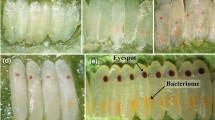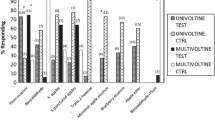Summary
Olfactometer tests with Asobara tabida (Nees 1834), a larval endo-parasitoid of frugivorous Drosophilidae showed that females are attracted to the odour of host food: a suspension of living yeast. This attraction decreased as the fermenting medium grew older and became less likely to contain suitable host stages. Olfactometer tests with — what was considered to be — A. tabida from two different microhabitats (fermenting fruits and decaying plants) showed a genetically determined difference in microhabitat odour preference between the two microhabitat ‘strains’. Each ‘strain’ preferred the odour of its own microhabitat. This odour preference was not modified by larval conditioning. Hybridization tests indicated that we were dealing with two sibling species: A. tabida and A. rufescens (Foerster 1862), reproductively isolated by a pre-mating isolation mechanism only. Enforced matings resulted in fertile female offspring. Some small morphological differences were detected. The two species live sympatrically, although each inhabits and is most attracted to its own microhabitat.
Similar content being viewed by others
References
Alphen JJM van, Drijver RAB (1982) Host selection by Asobara tabida Nees (Braconidae; Alysiinae) a larval parasitoid of fruit inhabiting Drosophila species. I Host stage selection with Drosophila melanogaster as host species. Neth J Zool 32:215–231
Alphen JJM van, Galis F (1983) Patch time allocation and parasitization efficiency of Asobara tabida, a larval parasitoid of Drosophila. J Anim Ecol 52:937–952
Alphen JJM van, Harsel HH van (1982) Host selection by Asobara tabida Nees (Braconidae; Alysiinae), a larval parasitoid of fruit inhabiting Drosophila species. III Host species selection and functional response. In: Alphen JJM van, Foraging behaviour of Asobara tabida, a larval parasitoid of Drosophila PhD-thesis State University of Leiden pp 61–93
Alphen JJM van, Janssen ARM (1982) Host selection by Asobara tabida Nees (Braconidae; Alysiinae) a larval parasitoid of fruit inhabiting Drosophila species. II Host species selection. Neth J Zool 32:194–214
Alphen JJM van, Nell HW (1982) Superparasitism and host discrimination by Asobara tabida Nees (Braconidae: Alysiinae), a larval parasitoid of Drosophilidae. Neth J Zool 32:232–260
Atkinson W, Shorrocks B (1977) Breeding site specificity in the domestic species of Drosophila. Oecologia (Berlin) 29:223–232
Baker RHA (1979) Studies on the interactions between Drosophila parasites, PhD-thesis, University of Oxford, p 238
Bouletreau M, David JR (1981) Sexually dimorphic response to host habitat toxicity in Drosophila parasitic wasps. Evolution 35:395–399
Carton Y (1977) Attraction de Cothonaspis sp. (Hyménoptère Cynipidae) par le milieu trophique de son hôte: Drosophila melanogaster. Coll. C.N.R.S., no 265 Comportement des insectes et milieu trophique:285–303
Dicke M, Lenteren JC van, Boskamp GJF, Dongen-van Leeuwen E van (1983) Chemical stimuli playing a role in host-habitat location by Leptopilina heterotoma (Thomson) (Hymenoptera: Eucoilidae) a parasite of Drosophila. J Chem Ecol (in press)
Flanders SE (1962) The parasitic Hymenoptera: specialists in population regulation. The Canad Entomol 94:1133–1147
Futuyma Y (1976) Behaviour genetics of olfactory responses in Drosophila. I Olfactory and strain differences in Drosophila melanogaster. Behav Genet 6:407–420
Galis F, Alphen JJM van (1981) Patch time allocation and search intensity of Asobara tabida Nees (Braconidae), a larval parasitoid of Drosophila. Neth J Zool 31:596–611
Hollander M, Wolfe DA (1973) Nonparametric statistical methods John Wiley & Sons
Huettel MD, Bush GL (1972) The genetics of host selection and its beearing on sympatric speciation in Procecidochares (Diptera: Tephritidae). Ent exp & appl 15:465–480
Parsons PA, Spence GE (1981) Ethanol utilization threshold differences among three Drosophila species. Amer Nat 117:568–571
Parsons PA, Stanley SM, Spence GE (1979) Environmental ethanol at low concentrations: longevity and development in the sibling species Drosophila melanogaster and D. simulans — Aust J Zool 27:747–754
Partridge L (1978) Habitat Selection. In: Krebs JR, Davies NB (eds) Behavioural Ecology; an evolutionary approach. Blackwell Scientific Publications Oxford, pp 351–376
Shorrocks B (1977) An ecological classification of European Drosophila species. Oecologia (Berlin) 26:335–345
Shorrocks B (1982) The breeding sites of temperate woodland Drosophila. In: Ashburner M, Carson H, Thompson JN (eds). The Genetics and Biology of Drosophila, vol. 3b. Academic press, London pp. 385–428
Stratton GE, Uetz GW (1983) The inheritance of courtship behaviour in Schizocosa wolf spiders (Araneae; Lycosidae) In: Huettel MD (ed) Evolutionary genetics of invertebrate behaviour. Plenum Publ Corp, NY
Strien-van Liempt WTFH van, Alphen JJM van (1981) The absence of interspecific host discrimination in Asobara tabida Nees and Leptopilina heterotoma (Thomson) coexisting larval parasitoids of Drosophila species. Neth J Zool 31:701–712
Vet LEM (1983) Host-habitat location through olfactory cues by Leptopilina clavipes (Hartig) (Hym.: Eucoilidae), a parasitoid of fungivorous Drosophila: the influence of conditioning. Neth J Zool 33 (3) (in press)
Vet LEM, Lenteren JC van, Heymans M, Meelis E (1983) An airflow olfactometer for measuring olfactory responses of hymenopterous parasitoids and other small insects. Physiol Entomol 8:97–106
Vinson SB (1981) Habitat location. In: Nordlund DA, Jones RL, Lewis WJ (eds) Semiochemicals, their role in pest control. J Wiley & Sons NY pp 51–77
Vinson SB, Barfield CS, Henson RD (1977) Oviposition behaviour of Bracon mellitor, a parasitoid of the boll weevil (Anthonomus grandis) II Associative learning. Physiol Entomol 2:157–164
Weseloh RM (1981) Host location by parasitoids. In: Nordlund DA, Jones RL, Lewis WJ (eds): Semiochemicals their role in pest control. J Wiley & Sons NY pp 79–95
Author information
Authors and Affiliations
Rights and permissions
About this article
Cite this article
Vet, L.E.M., Janse, C., van Achterberg, C. et al. Microhabitat location and niche segregation in two sibling species of Drosophilid parasitoids: Asobara tabida (Nees) and A. rufescens (Foerster) (Braconidae: Alysiinae). Oecologia 61, 182–188 (1984). https://doi.org/10.1007/BF00396757
Received:
Issue Date:
DOI: https://doi.org/10.1007/BF00396757




